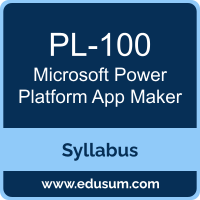 Use this quick start guide to collect all the information about Microsoft Power Platform App Maker (PL-100) Certification exam. This study guide provides a list of objectives and resources that will help you prepare for items on the PL-100 Microsoft Power Platform App Maker exam. The Sample Questions will help you identify the type and difficulty level of the questions and the Practice Exams will make you familiar with the format and environment of an exam. You should refer this guide carefully before attempting your actual Microsoft MCA Power Platform App Maker certification exam.
Use this quick start guide to collect all the information about Microsoft Power Platform App Maker (PL-100) Certification exam. This study guide provides a list of objectives and resources that will help you prepare for items on the PL-100 Microsoft Power Platform App Maker exam. The Sample Questions will help you identify the type and difficulty level of the questions and the Practice Exams will make you familiar with the format and environment of an exam. You should refer this guide carefully before attempting your actual Microsoft MCA Power Platform App Maker certification exam.
The Microsoft Power Platform App Maker certification is mainly targeted to those candidates who want to build their career in Power Platform domain. The Microsoft Certified - Power Platform App Maker Associate exam verifies that the candidate possesses the fundamental knowledge and proven skills in the area of Microsoft MCA Power Platform App Maker.
Microsoft Power Platform App Maker Exam Summary:
| Exam Name | Microsoft Certified - Power Platform App Maker Associate |
| Exam Code | PL-100 |
| Exam Price | $165 (USD) |
| Duration | 120 mins |
| Number of Questions | 40-60 |
| Passing Score | 700 / 1000 |
| Books / Training | PL-100T00-A: Microsoft Power Platform App Maker |
| Schedule Exam | Pearson VUE |
| Sample Questions | Microsoft Power Platform App Maker Sample Questions |
| Practice Exam | Microsoft PL-100 Certification Practice Exam |
Microsoft PL-100 Exam Syllabus Topics:
| Topic | Details |
|---|---|
Design and manage business solutions (35-40%) |
|
| Identify Microsoft Power Platform components |
- Determine the required Microsoft Power Apps app type for a given business scenario - Determine which Microsoft Power Platform components meet a given business scenario - Describe business logic in Microsoft Dataverse - Describe connectors - Describe use cases for cloud flows and desktop flows - Describe use cases for AI and Microsoft Copilot in Microsoft Power Platform - Describe Microsoft Power Platform environments - Describe use cases for Power Automate Process Mining - Determine reporting options for given business scenarios including views, Microsoft Power BI visualizations, and dashboards |
| Configure and manage Microsoft Dataverse |
- Create tables and table columns based on a data model
- Link tables by using lookups - Configure Dataverse business rules - Describe how Dataverse uses role-based access control (RBAC) - Add table permissions to existing Dataverse security roles - Create tables and table columns by using Copilot in Dataverse - Import and export data by using Microsoft Excel - Determine when to use Microsoft Dataverse for Teams or Microsoft Dataverse |
| Manage Microsoft Power Platform components during development |
- Create a Dataverse solution
- Export and import a Dataverse solution - Export and import a non-solution canvas app or a non-solution cloud flow - Add existing components to a Dataverse solution |
Analyze and visualize data (10-15%) |
|
|
Create and consume Microsoft Power BI dashboards
|
- Create a simple report from an existing dataset by using Power BI Service
- Create Power BI dashboards from existing reports - Embed Power BI dashboards and tiles in canvas apps and model-driven apps - Share Power BI dashboards |
| Describe AI Builder models |
- Describe use cases for AI Builder
- Describe the differences between prebuilt models and custom models - Describe the process for training custom models - Use a model from within Power Automate or Power Apps |
Create business solutions (50-55%) |
|
|
Create and manage model-driven apps
|
- Create and configure model-driven apps
- Create and configure Dataverse table forms - Create and configure Dataverse table views - Share model-driven apps with other users and groups - Create and configure model-driven app dashboards - Create and configure model-driven app charts |
|
Create and manage canvas apps
|
- Connect to data sources in canvas apps
- Interpret app checker results - Manage versions of canvas apps - Publish canvas apps - Share canvas apps with other users and groups - Add canvas app assets and components - Describe modern controls and themes |
|
Create and manage screens for canvas apps
|
- Determine when to use screens, forms, containers, galleries, buttons, labels, input controls, images, charts, and custom controls
- Configure UI elements - Implement Power Fx formulas - Implement collections and variables - Run a Microsoft Power Automate cloud flow from a canvas app |
|
Create Power Automate cloud flows
|
- Describe types of triggers
- Configure triggers - Configure flow steps - Test and troubleshoot a cloud flow - Implement conditional logic - Create approvals and monitor the approval process by using Power Automate and Microsoft Teams - Share cloud flows |
To ensure success in Microsoft MCA Power Platform App Maker certification exam, we recommend authorized training course, practice test and hands-on experience to prepare for Microsoft Power Platform App Maker (PL-100) exam.
